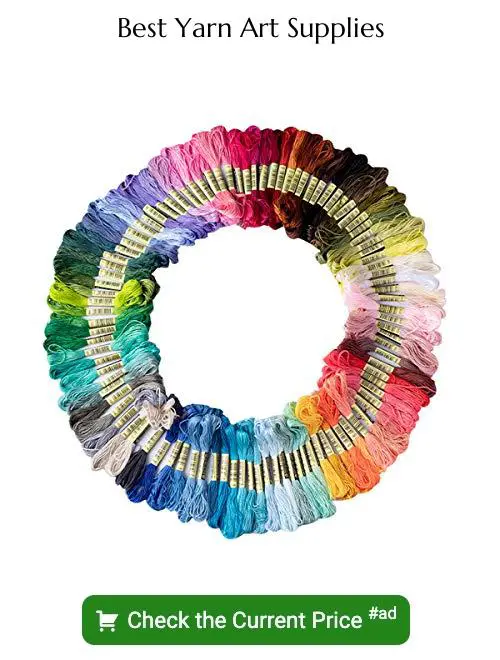Discover the fascinating world of yarn art as we explore its various types, unraveling creativity and innovation in every strand.
Are you a fan of yarn crafts? Do you love the feeling of soft, colorful fibers running through your fingers as you create something beautiful? If so, then you’re in luck! Yarn art is a vast and diverse world filled with endless possibilities. From crocheting to knitting, weaving to macrame, there are so many different types of yarn art to explore.
In this blog post, we’ll take a closer look at some of the most popular and exciting forms of yarn art out there. So grab your hooks and needles, settle in with your favorite skein of yarn, and let’s dive into the wonderful world of yarn crafting!
Yarn Painting
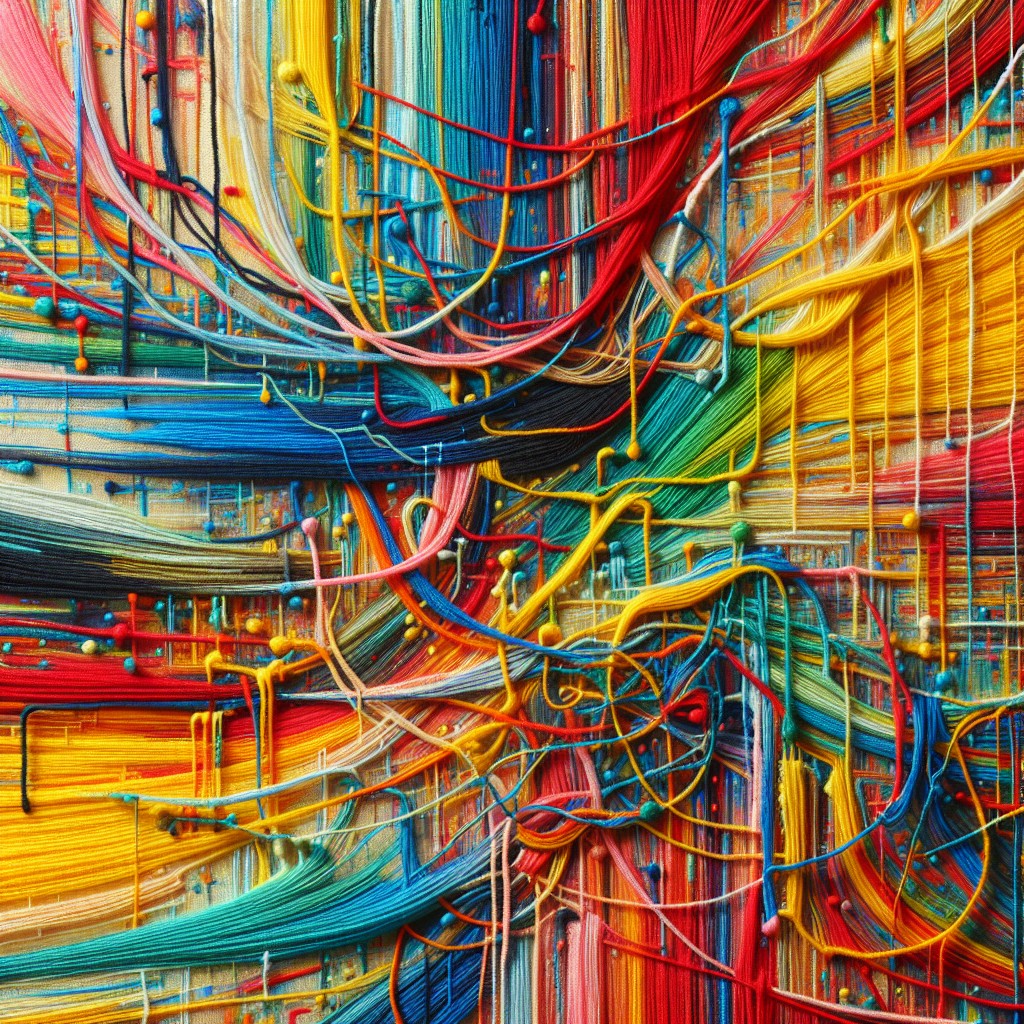
Yarn painting is a unique form of yarn art that originated in Mexico. It involves using brightly colored yarn to create intricate designs on a flat surface, such as cardboard or wood.
The artist first applies beeswax or resin to the surface and then presses the yarn into it, creating a textured and vibrant image.
One of the most famous practitioners of this art form was Huichol artist Ramón Medina Silva, who created stunning pieces depicting traditional Mexican motifs like animals and plants using only colorful threads.
While traditional yarn painting techniques are still used today by indigenous communities in Mexico, modern artists have also adapted this technique to create contemporary works that push boundaries and challenge expectations. Yarn paintings can be found in galleries around the world as well as public spaces like murals.
Crochet Art
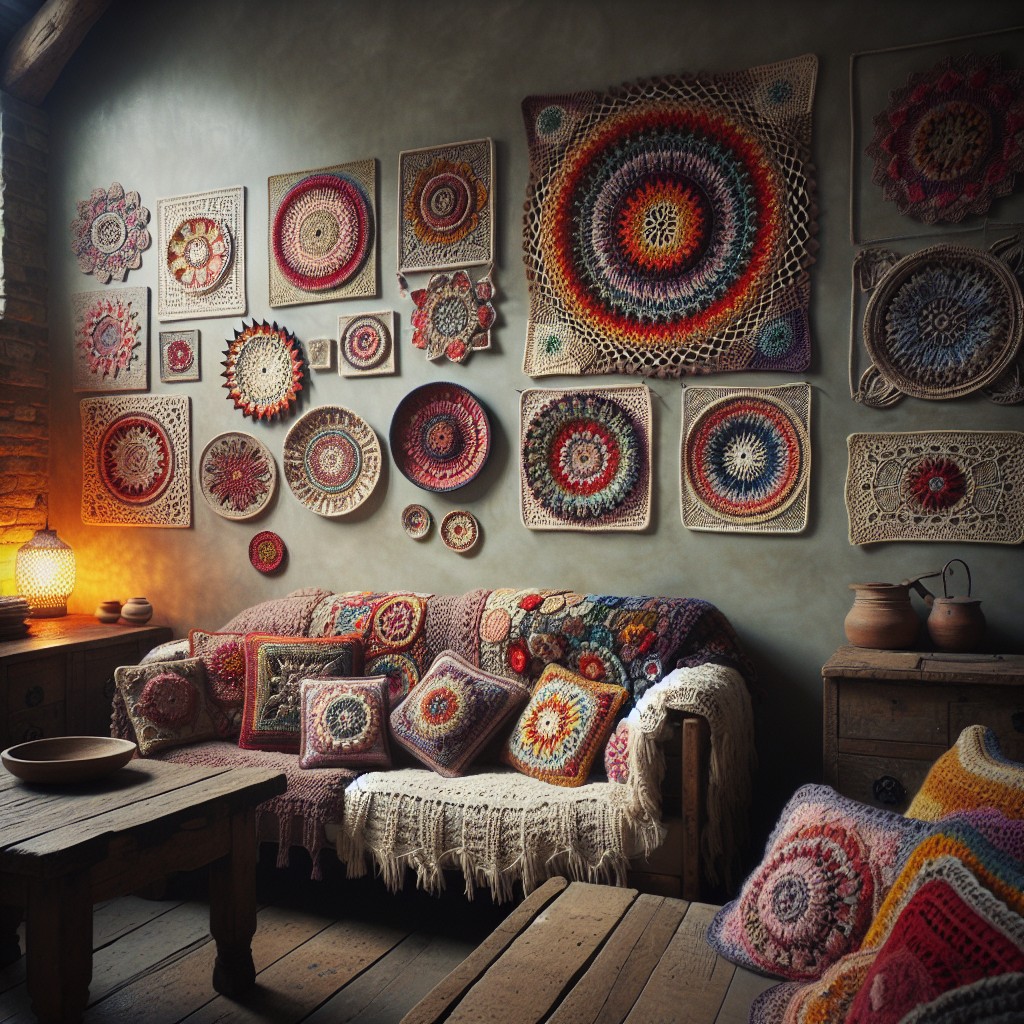
It’s an incredibly versatile craft, and the possibilities are endless when it comes to what you can create with just a hook and some yarn.
One of the most exciting things about crochet art is its ability to bring even the simplest designs to life. From blankets and scarves to intricate doilies, amigurumi toys, or even wearable garments like dresses or hats – there’s no limit on what you can make using this technique.
Many artists have taken crochet beyond traditional applications into more unconventional forms such as street installations or large-scale sculptures. Crocheted pieces have been used in public spaces for their colorful aesthetic appeal while also raising awareness for social issues like environmental conservation.
Knitted Sculptures
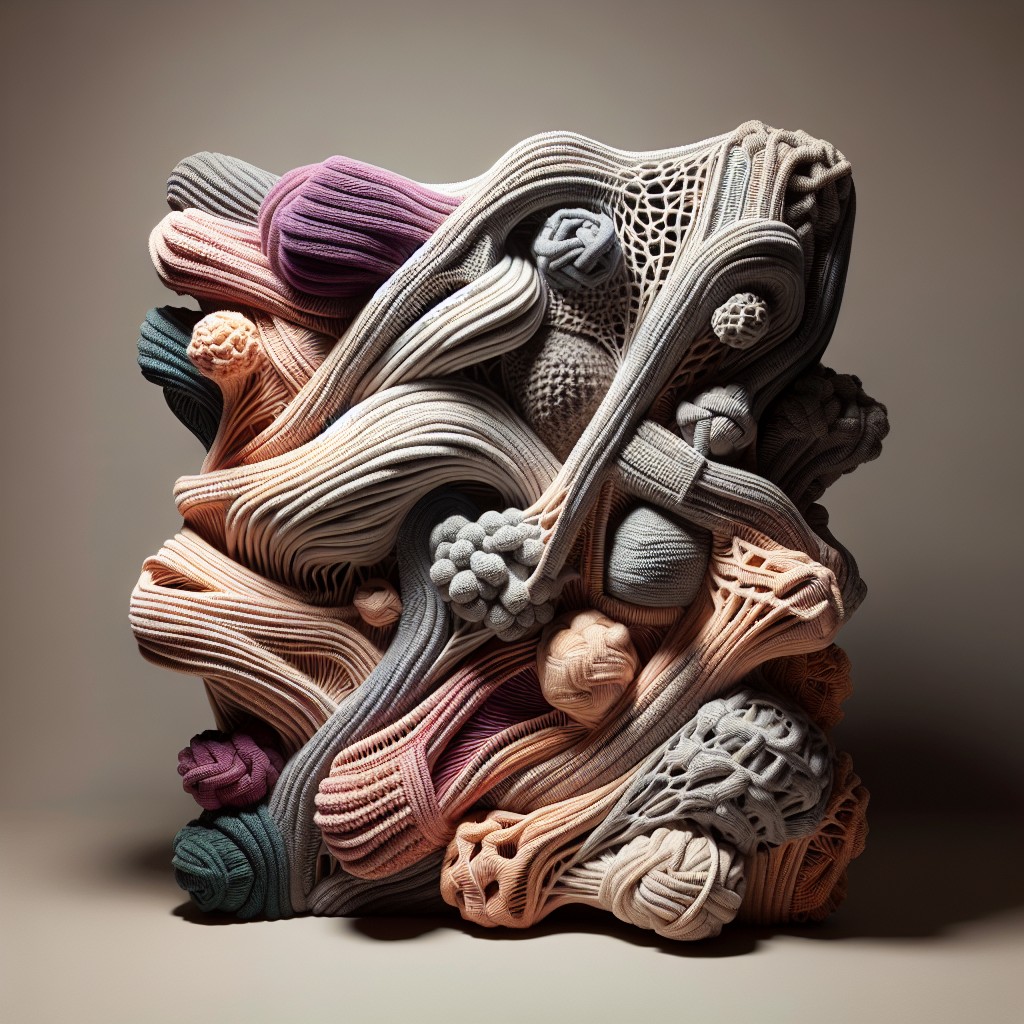
Knitted sculptures are an excellent example of how this traditional craft can be transformed into something entirely new and exciting. These sculptures are made by knitting various shapes, sizes, and textures using different types of yarn.
One famous knitted sculpture artist is London-based artist Freddie Robins who creates thought-provoking pieces with her knitting needles. Her work ranges from small-scale objects like knitted guns to larger installations such as “The Dark Matters,” which features life-sized figures wrapped in black wool.
Another notable example is the work of Patricia Waller, a German artist who uses humor in her creations by combining cute animals with dark themes such as death or violence. Her works include crocheted rats hanging themselves on miniature nooses or teddy bears being dissected on operating tables.
Yarn Bombing
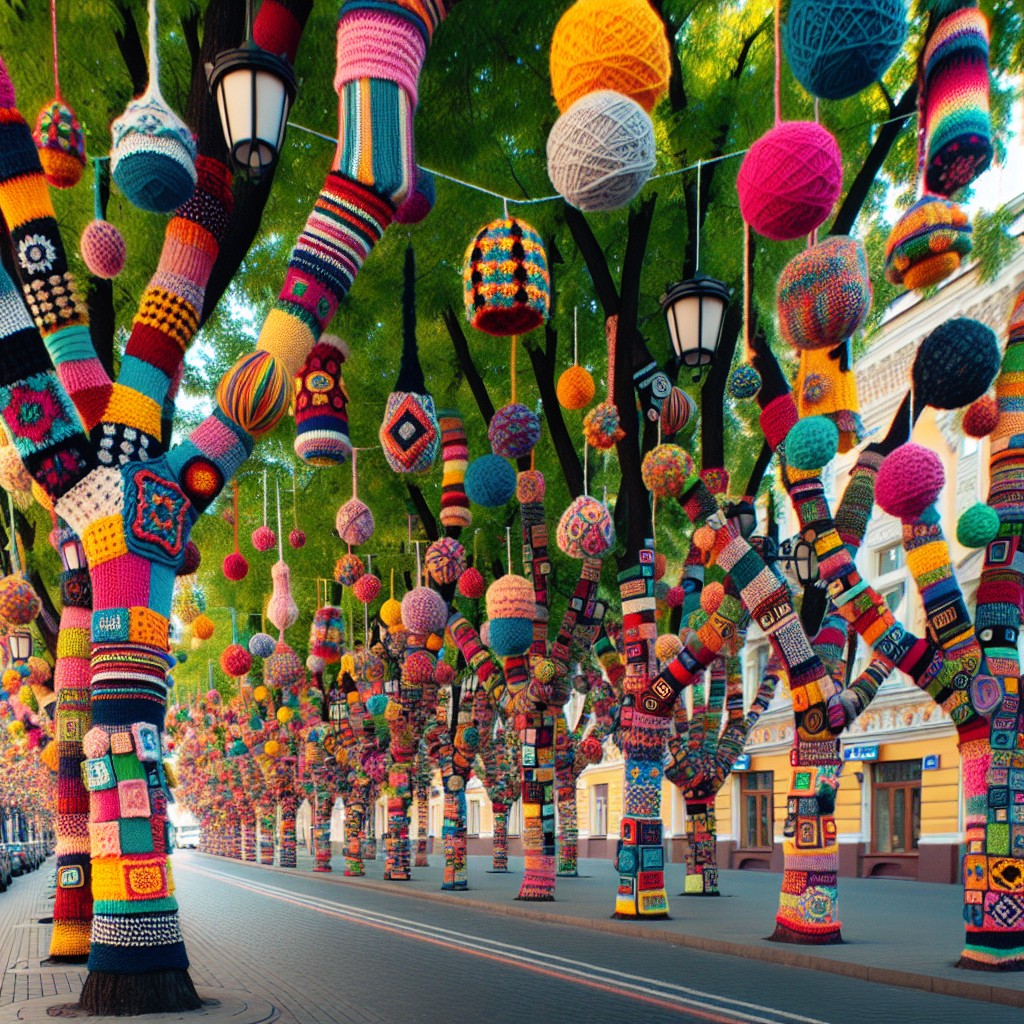
It involves covering public spaces, such as trees, benches, and statues with colorful knitted or crocheted yarn. Yarn bombing can transform dull urban landscapes into vibrant and eye-catching displays of creativity.
This type of yarn art is often done anonymously by groups or individuals who want to bring color and joy to their communities. The installations are temporary but can last for weeks or even months before they start to fade away due to weather conditions.
One notable example of yarn bombing was the 2018 Winter Olympics in Pyeongchang where an entire bridge was covered with over 2 million feet (610 km) of colorful knitting!.
Yarn bombing allows artists and crafters alike the opportunity to express themselves creatively while also bringing attention to social issues like environmentalism, community building, mental health awareness among others.
Macramé Creations
This technique involves knotting cords or strings together to create intricate patterns and designs. Macramé can be used to make everything from wall hangings and plant hangers to jewelry and clothing.
The beauty of macrame lies in its versatility, as it can be done with a variety of materials such as cotton, jute, hemp or even recycled t-shirts! The knots used in this craft are simple yet effective – square knots, half-hitch knots, double half-hitch knots – which when combined create stunning textures that add depth and dimensionality.
Whether you’re a seasoned crafter or just starting out on your yarn art journey, macrame is an excellent choice for anyone looking for a fun new project.
Weaving Art
It’s an ancient technique that has been used for thousands of years, and it continues to be popular today. Weavers use different types of looms, including hand-held frames and large floor models, to create intricate patterns and designs in their work.
One exciting aspect of weaving art is the variety of materials you can use. While traditional weavers often worked with wool or cotton fibers, modern artists experiment with all sorts of materials like paper strips, plastic bags or even metal wires! This allows for endless possibilities when it comes to creating unique textures and color combinations.
Whether you’re interested in creating functional items like blankets or rugs using traditional techniques such as Navajo weaving; exploring contemporary tapestry design; experimenting with free-form wall hangings; there are plenty ways you can incorporate this beautiful form into your yarn crafting repertoire!.
Tapestry Techniques
It involves weaving together different colored threads to create intricate designs and patterns. Tapestry techniques can be used to create anything from small wall hangings to large-scale installations.
One popular tapestry technique is called “weft-faced weaving.” This involves using a thicker weft thread than the warp thread, which creates a dense fabric with no visible warp threads. Another technique is “slit-tapestry,” where slits are left in the fabric as different colors are woven in, creating distinct shapes and lines.
In modern times, tapestries have become increasingly popular as decorative pieces for homes and businesses alike. They add texture, color, and personality to any space they occupy.
Whether you’re an experienced weaver or just starting out with yarn crafts, exploring tapestry techniques can open up new avenues of creativity within your work.
Latch Hook Rugs
Using a latch hook tool, you can easily loop yarn through a mesh canvas to create intricate designs and patterns. These rugs are not only functional but also add an artistic touch to any room.
One of the best things about latch hooking is that it’s easy for beginners to learn, yet still offers plenty of opportunities for creativity and experimentation. You can choose from countless colors and textures of yarn, as well as different sizes and shapes of canvases.
Whether you want to make a cozy rug for your living room or an eye-catching wall hanging, there’s no limit to what you can create with this technique.
Needle Felting
This technique allows for incredible detail and precision, making it perfect for creating small figurines, animals, or even entire scenes.
To get started with needle felting, you’ll need some basic supplies such as wool roving (unspun wool), a foam pad to work on (to protect your surface and the needles), and of course some felting needles. These specialized needles have tiny barbs along their length that help tangle the fibers together as you poke them repeatedly into the wool.
Once you have your materials ready, it’s time to start shaping your creation! Begin by rolling up a small amount of roving into a ball or other shape. Then use your needle(s) to poke at the fiber repeatedly until it starts holding its shape more firmly.
You can add more layers of color or texture by adding additional bits of roving onto your piece before continuing with further poking.
Amigurumi
These adorable little toys are often made with bright colors and intricate details, making them perfect for both children’s playthings and decorative items.
One of the great things about amigurumi is that it allows you to create something truly unique. With just a few basic stitches, you can bring your favorite characters to life or design your own original creations.
And because they’re so small and portable, amigurumi projects are perfect for taking on the go – whether you’re commuting on public transportation or waiting in line at the grocery store.
If you’re new to amigurumi, don’t worry! There are plenty of resources available online to help get you started. From beginner-friendly patterns to step-by-step tutorials on YouTube, there’s no shortage of information out there for those looking to try their hand at this fun craft.
Embroidery On Yarn
But did you know that embroidery can also be done on yarn? This unique form of yarn art involves using a needle and thread to create detailed designs directly onto the surface of the yarn itself. The result is a stunning piece of fiber art that combines both texture and color in beautiful ways.
To get started with embroidery on yarn, you’ll need some basic supplies such as an embroidery needle, thread or floss, scissors, and your chosen skein of yarn. You can use any type or weight of yarn for this technique but keep in mind that thinner threads will allow for more delicate details while thicker threads will create bolder lines.
Once you have your materials ready, start by sketching out your design onto the surface of the yard using chalk or another temporary marking tool. Then carefully stitch over these markings with your chosen colors until you’ve created an intricate embroidered pattern.
Yarn Collages
These pieces are created by layering different colors and textures of yarn onto a surface, such as canvas or cardboard, to create a textured and colorful design. Yarn collages can be abstract or representational, depending on the artist’s vision.
To create a yarn collage, you’ll need to gather an assortment of different types and colors of yarn. You can use any type that catches your eye – from thick wool roving to delicate embroidery floss – but keep in mind that each type will have its own texture and weight which will affect how it lays on your surface.
Once you’ve gathered your materials, start by sketching out a rough design for your piece. Then begin layering strands over one another until you achieve the desired effect.
You can also add other elements like beads or fabric scraps for added interest.
The beauty of creating with this technique is that there are no rules! Let yourself experiment with color combinations and textures until you find what works best for you.
Basket Weaving
It involves using natural materials such as grasses, reeds, and vines to create beautiful and functional baskets. Basket weaving can be done in many different styles and techniques, from coiling to plaiting to twining.
One of the great things about basket weaving is that it allows you to connect with nature in a unique way. You can gather your own materials from the wild or purchase them from local suppliers who specialize in sustainable harvesting practices.
Once you have your materials ready, basket weaving requires patience and attention to detail as each strand must be carefully woven into place. The end result is not only practical but also visually stunning – a testament to both the skill of the weaver and the beauty of nature’s bounty.
String Art Designs
This technique has been around for centuries, but it gained popularity in the 1960s as an artistic expression. String art designs can range from simple geometric shapes to complex patterns and images.
To create your own string art masterpiece, you’ll need some basic supplies such as wood boards, nails or pins, hammer, scissors and embroidery floss (or any other type of thin cord). You can start with a pre-made pattern or create your design by sketching it onto the board before nailing in place.
Once you have your design set up on the board with nails/pins placed at strategic points along its outline; tie one end of embroidery floss to one nail/pin then wrap it tightly around each nail/pin until all are connected forming lines between them. The result will be an intricate web-like structure that creates beautiful visual effects when viewed from different angles.
God’s Eyes Craft
It involves weaving colorful yarn around sticks to create beautiful and intricate designs. The craft was originally used as a spiritual tool, with each color representing different elements of nature or deities.
Today, God’s Eyes Craft has become popular among artists and crafters worldwide for its simplicity and versatility. You can use any type of yarn or stick to create your own unique design, making it an excellent project for beginners.
To make your own God’s Eye, start by crossing two sticks in the shape of a plus sign (+). Then wrap one end of the yarn around one stick and begin weaving it over and under each spoke until you reach the next spoke.
Continue this pattern until you’ve covered all four spokes evenly with your first color.
Next, switch to another color (or colors) by tying off the first strand at any point along one side before starting again on another side with new colored strands. Repeat this process until you have created multiple layers in various colors creating an eye-catching design!
Recommended Tools
Whether you’re a seasoned pro or just starting out, having the proper equipment can make all the difference in your finished product. Here are some recommended tools for various types of yarn art:
- Crochet: crochet hooks (in different sizes), stitch markers, tapestry needles
- Knitting: knitting needles (in different sizes and lengths), stitch markers, cable needles
- Weaving: loom (rigid heddle or floor loom), shuttle stick, warp thread
- Macramé: macramé cord/rope/string/yarn in various thicknesses and colors; scissors; tape measure/ruler
It’s important to invest in quality tools that will last long-term and help you achieve your desired results.
Types of Yarn
The texture, weight, and fiber content can all affect the final outcome of your project. There are many different types of yarn available on the market today, each with its own unique characteristics.
Some popular types of yarn include wool (which is warm and durable), cotton (which is lightweight and breathable), acrylic (which is affordable and easy to care for), silk (which has a luxurious feel but can be expensive) and alpaca or cashmere blends which offer softness as well as warmth.
It’s important to consider what you’ll be using your finished project for when selecting a type of yarn. For example, if you’re making something that will get a lot of wear like socks or mittens then wool might be an excellent choice because it’s sturdy enough to withstand frequent use.
On the other hand if you’re creating something decorative like wall hangings or tapestries then silk may work better due to its sheen which adds elegance while also being delicate enough not weigh down on any structure used in hanging them up.
Choosing the Right Yarn
With so many different types of yarn available, it can be overwhelming to know where to start. The first step in choosing the right yarn is considering what type of project you’ll be working on and what qualities you want your finished piece to have.
For example, if you’re making a cozy blanket or scarf, you may want a soft and warm wool or alpaca blend. If you’re creating an intricate lace shawl or doily, then a lightweight silk or cotton thread might work best.
Another important factor when selecting your yarn is its weight (thickness). Yarns come in various weights from super fine (lace) all the way up to super bulky (jumbo).
Each weight has its own unique characteristics that affect how it will look and feel in your finished piece.
Lastly, consider color options for your chosen type of fiber as well as texture variations such as variegated colors versus solid hues.
DIY Yarn Art Projects
From wall hangings to plant hangers, there are so many fun and easy projects you can make with just a few basic supplies.
One popular DIY yarn art project is the macrame wall hanging. With just some rope or twine and a few knots, you can create beautiful geometric designs that will add texture and interest to any room in your house.
Another fun project is the pom-pom garland. All you need is some colorful yarn, scissors, and cardboard circles or forks for making pom-poms.
String them together on a piece of twine or ribbon for an adorable decoration that’s perfect for parties or everyday use.
If you’re feeling ambitious, try making an oversized knit blanket using chunky yarn! This cozy addition will keep you warm during chilly nights while adding style to any space in your home.
Artistic Yarn Installations
These installations can range from small, intricate pieces to large-scale works that cover entire buildings or landscapes. One famous example is the “Wrapped Reichstag” by Christo and Jeanne-Claude, where they covered the entire German parliament building in Berlin with over one million square feet of silver fabric.
In recent years, many artists have taken up yarn as their medium of choice for creating stunning public art installations. From colorful crocheted trees to massive knitted sculptures, these artworks add a touch of whimsy and warmth to urban spaces.
One such installation is “The Knitted Wonderland” by Toshiko Horiuchi MacAdam at Hakone Open-Air Museum in Japan. This interactive playground features vibrant crochet structures that visitors can climb on and play around with.
Another notable example is London-based artist Shauna Richardson’s “Crochetdermy®️” series which showcases life-size animal sculptures made entirely out of crocheted wool! Her work has been exhibited all over the world including at The Natural History Museum in London.
Famous Yarn Artists
Many talented artists have made their mark in this field, creating stunning works that showcase the beauty and versatility of yarn. One such artist is Olek, who is known for her colorful crocheted installations that cover entire buildings and public spaces.
Another famous name in the world of yarn art is Sheila Hicks, whose work spans several decades and includes everything from large-scale fiber sculptures to small weavings. Her pieces are often inspired by nature or cultural traditions from around the world.
Other notable names include Toshiko Horiuchi MacAdam (known for her intricate crochet playgrounds), Joana Vasconcelos (who creates massive textile sculptures using a variety of materials including wool), and Magda Sayeg (the founder of “yarn bombing” – covering everyday objects with knitted or crocheted fabric).
These artists have not only pushed boundaries but also brought attention to an often-overlooked medium through their creativity. Their works inspire others to experiment with different techniques while showcasing how versatile yarn can be as an artistic medium.
Tips for Yarn Art Beginners
But fear not! Here are some tips for beginners that will help you get started on your yarn crafting journey:.
1. Start with simple projects: Don’t try to tackle a complicated pattern right away.
Begin with something easy like a scarf or dishcloth and work your way up.
2. Choose the right tools: Make sure you have the appropriate size hook or needles for your project and invest in good quality materials.
3. Practice tension control: Tension is crucial in creating even stitches, so practice keeping an even tension as you work.
4. Learn basic stitches first: Mastering basic stitches such as single crochet, double crochet, knit stitch and purl stitch will give you a solid foundation for more complex patterns later on.
5. Join online communities/groups/forums – There are many online groups dedicated solely to yarn crafts where members share their experiences and offer advice; joining one can provide inspiration while also giving access 24/7 support from fellow crafters around the world!
FAQ
What is YarnArt called?
YarnArt is called fiber art, which is a type of fine art that utilizes natural or synthetic yarn or fabric, focusing on the materials and manual labor involved in creating the artwork.
What are the different types of wool art?
There are various types of wool art such as weaving (the oldest form), painting, knitting, crocheting, and knotting, used to create diverse items like clothing, blankets, and rugs with intricate patterns.
What are pictures made with yarn called?
Yarn paintings are pictures made with yarn, originally created by the Huichol Native Americans.
How do various yarn art techniques differ from one another?
Various yarn art techniques differ by the methods used for manipulating the yarn, such as knitting, crocheting, weaving, and macramé, each requiring distinct tools and skillsets.
What is the process of creating yarn sculptures?
The process of creating yarn sculptures involves shaping and manipulating yarn into various forms and designs, often using techniques such as knitting, crocheting, or weaving.
What are the cultural significance and history behind different yarn art forms?
Yarn art forms carry significant cultural importance and historical context, often serving as functional items, symbols of skill and tradition, and a means of storytelling and expression for numerous cultures across the globe.
